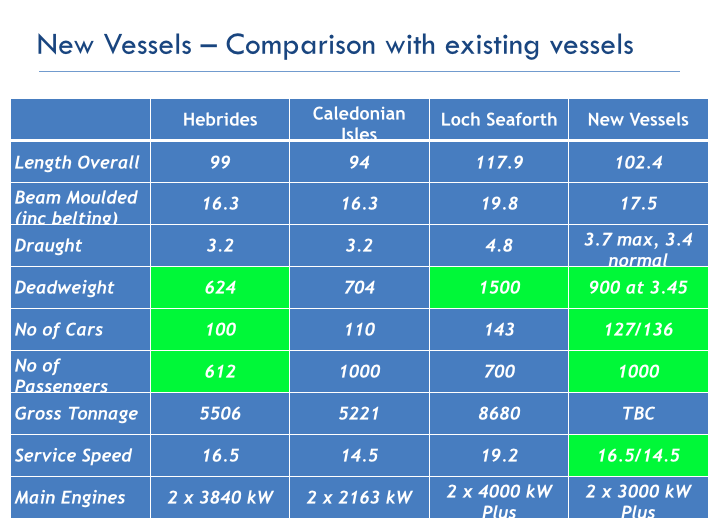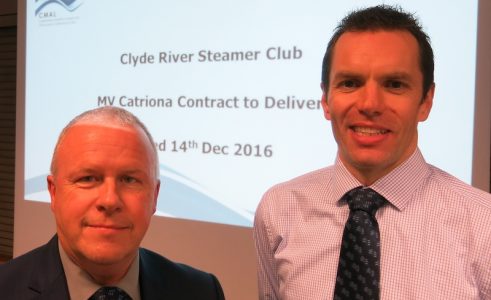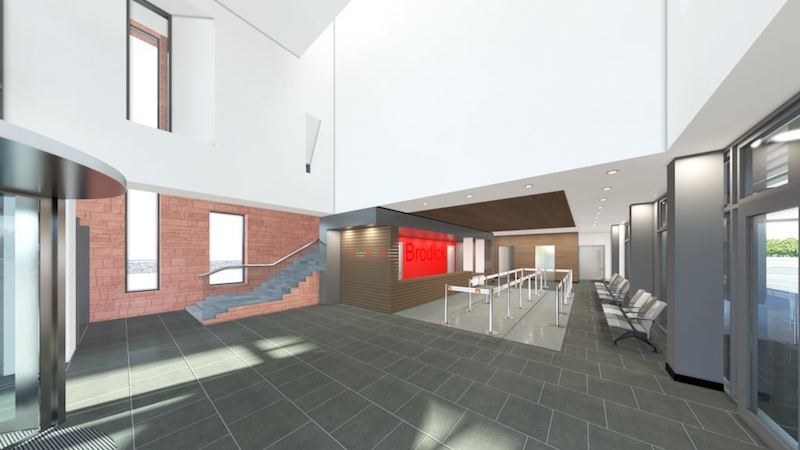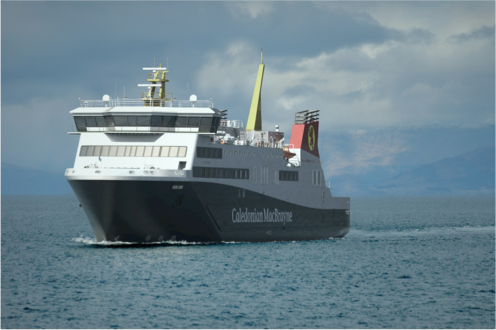
A computer-generated impression of how the two new big ferries under construction at Port Glasgow will look. They are expected to enter service within four months of each other in 2018-19 on the Arran and Uig triangle runs. There will be no open deck space for passengers forward of midships. Copyright CMAL
Our December 2016 meeting at Jurys Inn, Glasgow, was a landmark event in CRSC’s recent history: it brought us face-to-face with two key professionals in the world of vessel procurement and harbour development in the west of Scotland. What they had to say was often revealing, sometimes funny and never less than fascinating. Rob Beale reports.
On December 14 we were treated to a presentation by two senior executives of Caledonian Maritime Assets Limited (CMAL) — John Salton, Fleet Manager and Project Director, and Ramsay Muirhead, Head of Civil Engineering. About 100 people — the biggest midwinter attendance for many a year — squeezed into the room in anticipation of this talk, which divided into three sections:
John spoke about the build process of Catriona, CMAL’s newest vessel, now in service for CalMac Ferries Ltd between Tarbert, Portavadie and Lochranza.
Ramsay gave an insight into the redevelopment at Brodick, including the new pier, linkspan, marshalling area and terminal building.
John and Ramsay then outlined the other major projects on CMAL’s books, including two new big ferries being built at Port Glasgow, and other pier and slipway renewals.
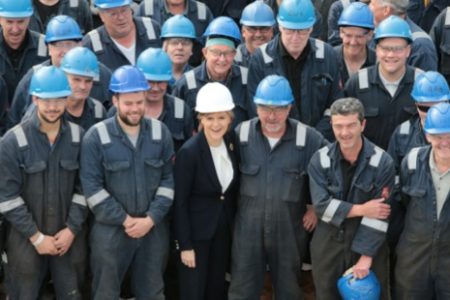
First Minister Nicola Sturgeon with Ferguson Marine shipyard workers at the steel cutting for Catriona. Copyright CMAL
John’s presentation was entitled ‘MV Catriona. Contract to Delivery’. He told us about his early career as a CalMac engineer, and reminisced about his favourite posting – on the former Small Isles vessel Lochmor. A detailed run-through of Catriona’s build at Ferguson Marine, Port Glasgow, was accompanied by some staggering statistics — for example, no fewer than 11,000 metres of electrical cable are employed in the 43-metre ship. It was also noted that most of the vessel’s superstructure is made of aluminium.
We were treated to a time-lapse video of Catriona’s growth on the slip, as well as a film of launch day (11 December 2015), which roused much laughter due the comments made by some of the staff and guests. After attending the launch, one little schoolgirl remarked “[The ferry] was really well made because there were no holes in it”! Among the professional shipyard workers who were interviewed on camera was CRSC member Craig Osborne.
Catriona then had to be fitted out before undergoing extensive tests and trials. John explained that one such trial involved berthing at Largs and loading a three-axled coach and a 44-ton lorry, to check that the rear of the vehicles cleared the ramp. Apparently some large modern vehicles have managed to get stuck on ferry ramps – half-on, half-off, with their drive wheels not even touching the ground. We also heard that Catriona has virtually doubled Loch Tarbert’s capacity while running on half the fuel, and that her batteries are more efficient than her two ‘hybrid’ predecessors, Hallaig and Lochinvar. Despite the greater cost of her machinery compared to conventional diesel engines, Catriona is expected to repay her capital costs by the end of her estimated 30-year lifespan.
Ramsay began with a summary of the impressive array of pier redevelopment projects he has been involved in while working for CMAL — at Largs, Kennacraig, Port Ellen, Gourock and Brodick. The last-named was the subject of his presentation.
We learned that the main reason for the huge investment at Brodick was that existing facilities are either too old or too limited to cope with the demands of today’s service: the linkspan, for example, is the oldest in the network at 46 years, while the booking office and marshalling area are too small to cope with ever-growing volumes of traffic.
The increasing draught of ferries has also necessitated a berth in deeper water than the traditional pier, the foundations of which would have been upset by any more dredging work.
The complexities of the planning and funding process were followed by a site description and a fascinating ‘fly-through’ video of what the finished project is designed to resemble.
The new pier, situated south-east of the existing structure, will point north-north-east, with facilities for ships on both sides. Ramsay noted that it is on schedule to open in August 2017, so hopefully calls from Waverley will be able to resume. A large marshalling area with room for 150 per cent of Caledonian Isles’ capacity has been built on reclaimed land adjacent to the new two-storey, sandstone-clad terminal building. Ramsay explained how more than 18,000 tons of dredged spoil had been removed around the new pier structure, two thirds of which was reused to create the marshalling area, with the remaining third donated to Brodick beach.

September 2016: bird’s eye view of the two new 102-metre ferries taking shape at Ferguson Marine, Port Glasgow. Copyright CMAL
We had a bird’s eye view of the redevelopment process, thanks to another time-lapse video portraying day-by-day changes to the Brodick harbour front. This underlined how the complex construction works had proceeded without disruption to the ferry service at the ‘old’ pier.
Ramsay finished his section with a brief look at a couple of CMAL’s upcoming projects. The slipways at Rhubodach and Colintraive need replacing, which will take nearly a year, and the Gourock linkspan, the second oldest in the network, will be renewed.
Finally, we looked to the future as both John and Ramsay told us about the two new ‘dual fuel’ vessels under construction at Port Glasgow (capable of operating on conventional marine diesel or LNG). Detailed three-dimensional artists’ renditions were displayed, which overall impressed, though for some enthusiasts there was disappointment at the lack of a walkway round the bow section beneath the bridge: John said the need for more internal seating for passengers necessitated sacrificing some deck space, and it was hoped that a Loch Seaforth-style forward observation lounge would provide some compensation.
The first ship, numbered 801, will hopefully be launched in October 2017 and begin service at Arran the following summer. Number 802, destined for the Uig triangle, should follow four months later. The vessels will be larger than the ships they are due to replace, but will be far greener, having more efficient engines. They will each have three 800Kw bow thrusters and an 800Kw stern thruster. Their capacity will be for 127 cars and 1,000 passengers, 700 of which should be comfortably seated inside. Pictures of the current state of the hulls showed us how quickly work is progressing. The names of the ships will be the subject of a soon-to-be-announced public competition.
The two speakers complemented each other very well: where John was down-to-earth and humorous, Ramsay was more urbane and refined. Both came across as thoroughly professional, knowledgeable and well prepared, with a sophisticated array of illustrations.
Members and guests listened with intense concentration throughout the presentation, and showed their appreciation at the end with rousing applause, augmented by Gordon Law’s vote of thanks. The only downside now is, how do you follow that?!
CRSC’s next meeting is on 11 January 2017: please join us. For more News and Reports, click here.
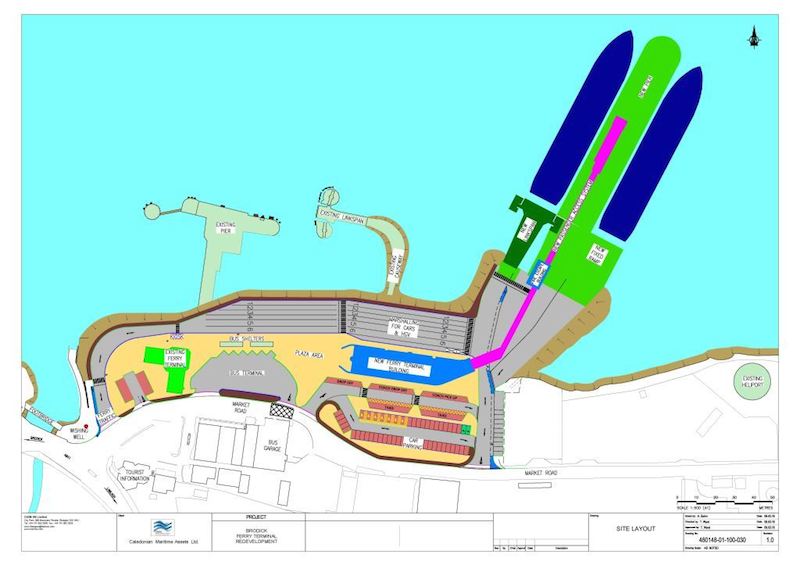
Overview of the Brodick harbour development, showing the old pier and causeway to the left and the two new berths to the right. A covered walkway will extend from the terminal building’s upper floor to the ship’s gangway. Copyright CMAL
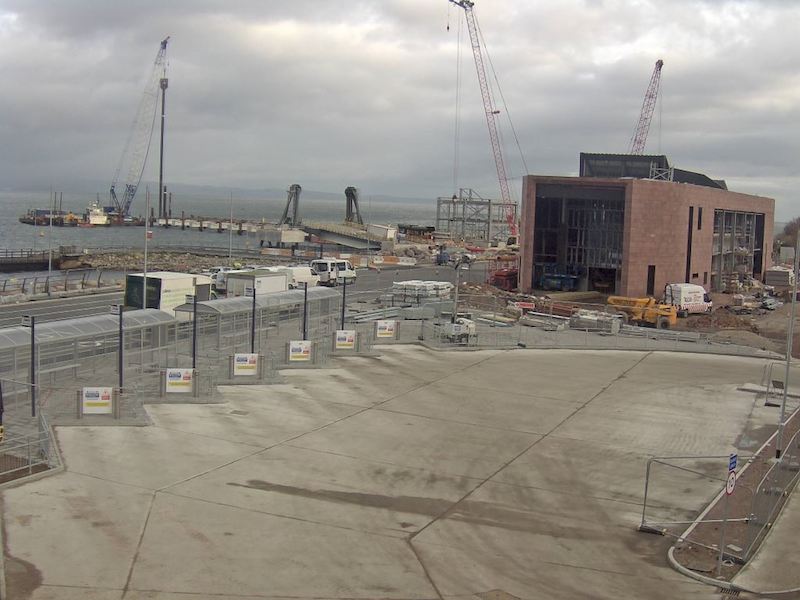
State of construction at Brodick in December 2016, with the new bus stance in the foreground, terminal building to the right and pier works underway to the left. Copyright CMAL
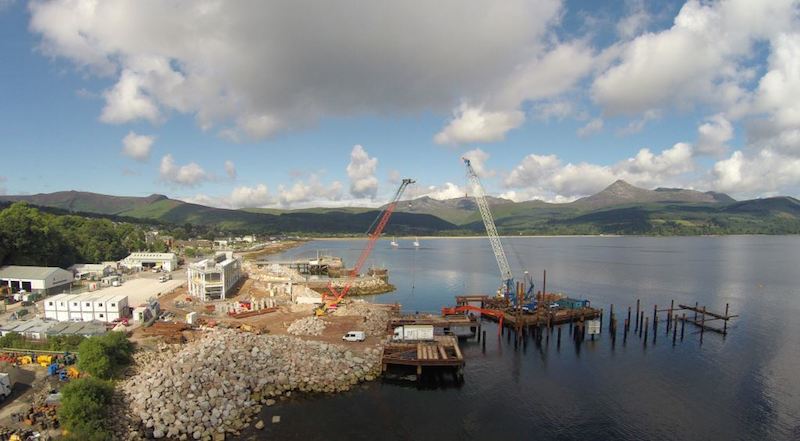
The way it was in July 2016: already the harbour construction in the foreground dwarfs the old pier and causeway behind the red crane. Much of the harbour development is on reclaimed land. Copyright CMAL

Full house: the back half of the room during CRSC’s December 2016 meeting. Among the audience were CMAL Director of Vessels Jim Anderson, standing sixth from right, and John Whittle, CalMac’s first managing director, standing second from right. There was a lively question-and-answer session after the presentation. Copyright CRSC
